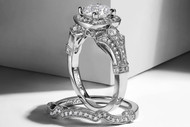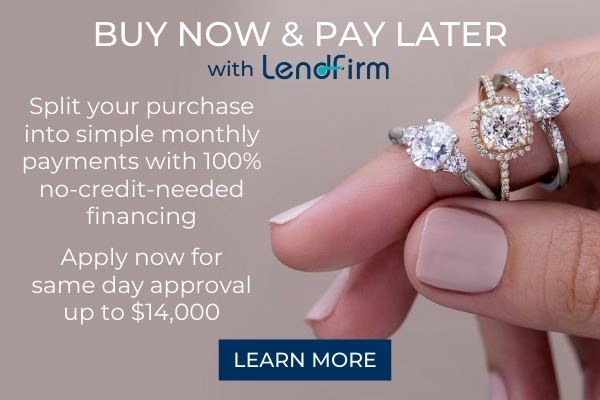Oct 14th 2021
What is a Vintage Style Engagement Ring?
A flashy diamond engagement ring can definitely be a sweet, unexpected treat. But those big sparklers aren’t for everyone. If your special someone has a penchant for times past, a vintage style engagement ring just might make the perfect gift! We’re here to help you learn more about these old-fashioned beauties so you’re well-equipped when you start ring shopping!
Vintage vs. Vintage Style Engagement Rings
First, you should know that vintage engagement rings are different than vintage style engagement rings. The term “vintage” can refer to rings that were crafted as recently as 20 or 30 years go, but most vintage rings are more than 50 years old. Vintage style engagement rings (or vintage-inspired engagement rings), on the other hand, are modern pieces that simply incorporate vintage elements, such as beading, engraving, scallop work and pave diamonds. Check out our selection!
Since vintage style rings were produced recently, you’ll notice differences in quality when comparing them with authentic vintage rings. For example, diamonds set in vintage style rings tend to have better cuts, clarity and color due to improvements in technology. They’re also easier to maintain and repair, in case your ring experiences damage.
*Pro Tip: When ring shopping, you might come across antique engagement rings. Although “antique” and “vintage” are frequently used interchangeably, antique rings are usually more than 100 years old! Check out our antique selection!
Vintage Ring Trends
From yellow gold and colored gemstones to platinum and geometric shapes, vintage style engagement rings can look very different, depending on the era they’re representing. Read on to see how history influenced various jewelry designs.
Victorian Era (1837-1901): Pieces produced during this time offered a rich, romantic appearance and featured designs resembling flowers, birds and hearts. Yellow and rose gold were commonly used for rings, and diamonds were set in silver to enhance their sparkle. Solitaire and halo rings became popular in this era. But since round cut diamonds weren’t developed yet, common diamond cuts included old mine (similar to today’s cushion-cut stones), old European, step and marquise cuts. Pieces also incorporated various shades of blue, as this was Queen Victoria’s favorite color.
Ring Shopping Tip: Since clusters of diamonds became a fashion statement during the Victorian era, you can’t go wrong with a cluster ring for your significant other! This type of engagement ring features close-set smaller diamonds to resemble a larger stone. The stones sometimes form unique shapes, such as a flower or starburst, and you might see a ruby, emerald or sapphire as the center stone.
Edwardian/Belle Epoque Era (1901-1914): Rings from this period featured platinum for the first time, allowing for lighter, lacy designs. Jewelers often twisted and curled flexible threads of metal into delicate decorations, such as ribbons and vines, on the band or elsewhere on the engagement ring (aka filigree). But during the latter part of the era, pieces became less elaborate. Edwardian jewelry also commonly featured colored gemstones, pearls and diamonds.
Ring Shopping Tip: Solitaire rings are classic and timeless. But to give your spouse-to-be an Edwardian twist, look for a less sophisticated solitaire that sits closer to one’s finger and features a sapphire, ruby or diamond with an old mine or old European cut.
Art Deco (1915-1935): Unlike the previous two eras, Art Deco rings highlighted bold, geometric shapes, repeating patterns and beading (aka milgrain). While colored gemstones and step-cut diamonds were still popular, the round cut diamond was introduced as a result of technological advances. These rings are one of the most desired vintage engagement rings, partly due to their eye-catching designs.
Ring Shopping Tip: If your partner likes a bold look, consider a piece that will make a statement, like a large emerald or marquise-cut center stone that’s bordered by smaller baguettes.
Retro Era (1940-1965): Since platinum was designated for use in World War II, yellow and rose gold made a comeback during this time. Jewelers began creating larger pieces, and bold, appealing ring designs became the norm as a tribute to the glitz and glamour of Hollywood’s Golden Age. This period saw another important change: Center stones became the main focus of ring designs. Before the war, few engagement rings incorporated a center diamond. But after the 1930s, center diamonds were the standard for rings, and stone sizes increased when the Great Depression ended.
Ring Shopping Tip: In this case, a simple ring design is better. Let the diamond be the star of this show against a yellow or rose gold band. Platinum once again became the metal of choice following World War II, so this is also a perfectly acceptable option for your ring band.
Have a question? We can help!
Gage Diamonds is Chicago's premier jewelry showroom and online retailer of engagement rings, wedding bands, and fine jewelry. We offer a dazzling selection of vintage style engagement rings and antique engagement rings.
We’re committed to helping you find the ring of your dreams. For inspiration, browse our website or set up an appointment with a member of our trusted staff at our in-person showroom.
We offer no-credit-needed financing – apply and get your approval within 24 hours!
Pay over time, because love shouldn’t wait.
 VISIT OUR SHOWROOM
VISIT OUR SHOWROOM Reviews on Google!
Reviews on Google!





